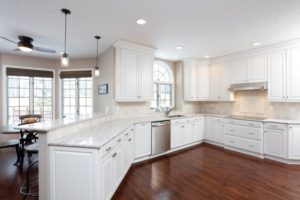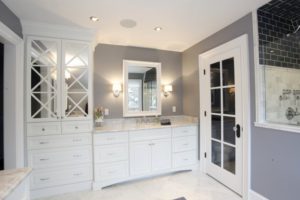Successful design is the sum of its parts. Think about putting together a great outfit: You start with basics and then layer on accessories to make it really pop. To do home lighting right, that same layering approach is a must. As a designer at Dover Home Remodelers in North Olmsted, Ohio, it’s my job to help customers walk through the process.
In the kitchen:
- Can lighting — on a dimmer switch to allow for adjustment. This is an essential. When we design a new kitchen and customers see the grid of can lights
 on the ceiling, they worry about a blinding blaze of light. But that’s not the result: We install all kitchen lighting on dimmers so homeowners can soften the feel of the room or increase light, as needed.
on the ceiling, they worry about a blinding blaze of light. But that’s not the result: We install all kitchen lighting on dimmers so homeowners can soften the feel of the room or increase light, as needed. - Task lighting. My rule of thumb is to add light over the sink, the stove and to illuminate prep areas within the kitchen. For some room designs, these might be pendant lights and for others, it could be additional can lights or track fixtures.
- Mood lighting. Pendant lights over a bar, a chandelier over a dining table, a light fixture over the island—these are all ways to add texture, color and design style to your kitchen, while providing another layer of lighting that can be used independently or in tandem with can lighting.
- Under-cabinet lighting. A great way to add dimension to your kitchen, but with added functionality. These are an excellent source for added task lighting on the counters; and when all other fixtures are turned off, these lights can be illuminated at night for a beautiful, soft glow.
- Display lighting. Puck lights are an ideal and efficient solution for lighting up glass-front cabinets for displays.
Don’t forget: It is important to have switches located in locations that are both convenient and accessible. Consider having switches at each doorway/entrance to the room, near table nooks, under cabinets and next to the sink.
In the bathroom:
- Vanity lighting. Depending on the layout and size of the vanity, the lighting specifications could include one large fixture over the mirror, or single
fixtures over multiple mirrors; and/or sconces on either side of the vanity mirror. This lighting configuration can be adjusted based on the absence or availability of natural light in the room.
- Shower lighting. Most often, the shower/fan combination is used to illuminate the shower space and provide an exhaust for moisture. Of course, these are waterproof fixtures—and the switches should be installed just outside of the shower entrance.
- Focal point lighting. We’re seeing a lot of free-standing tubs incorporated in bathrooms designs these days. It’s important to note that while the idea of a beautiful chandelier suspended over the tub sounds fabulous—it’s a hazard. And it’s also a building code violation.
My suggestion is to install an additional can light, or illuminate with track lighting that can be adjusted to highlight the tub.
In the family room:
- Ambient lighting. This serves as the general light source for the room. For extra comfort, you may opt for a ceiling fan fixture that includes lights, which is easy to customize or change out with available light kits. Flush or semi-flush mount fixtures and chandeliers can also be used as the primary source of light for the room—but be sure to follow the layering rule: No one and done.
- Task lighting. Table and floor lamps are the ideal way to add task-specific lighting for reading, games, etc. As you plan your space, be sure to factor in outlets—in the wall and/or ceiling—to give you the options you need for access.
- Display lighting. Track lighting is ideal for showcasing artwork on the wall or in other display areas.
In addition to layering your lighting, keep scale and size in mind as you select fixtures: Installing a fixture that is too large can drown out your space, and undersized lighting can throw off the room’s proportions.
My design mantra: Don’t be afraid to mix it up. When you achieve the ideal balance with your lighting, the finished effect will feel right at home.
The Best Is Yet To Come,
Beth Orr Schroeder







